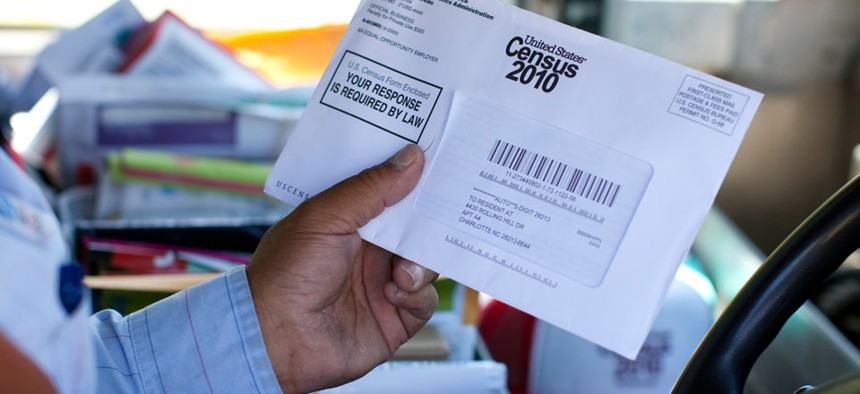Census Bureau Struggles With Sequester and Pressure to Cut Costs
House members voice privacy concerns in move toward interagency records sharing.
Newly installed Census Bureau Director John Thompson on Wednesday said sequestration has forced his agency to delay several economic products and field tests of key reforms needed to plan the 2020 Census. He called for full funding of the Obama administration’s request for a fiscal 2014 budget hike of $150 million.
In 2013, “we’ve already had to move several tests back to 2014, and 2014 is a critical year for putting us in a position to decide in 2016 what research and development we will do in the decennial census,” Thompson told the House Oversight and Government Reform Subcommittee on the Federal Workforce, U.S. Postal Service and the Census.
“Put at risk,” he said, would be experiments in use of existing administrative records to fill in missing information from hard-to-reach Americans as well as “adaptive design” techniques that use previous records to determine the most efficient way to deploy resources to track down the estimated 37 percent of the population that fails to respond to the decennial mailed-out census questionnaire.
Thompson was responding to questions from Rep. Stephen Lynch, D-Mass., ranking member of the subcommittee, who said the bureau is operating with funding 13 percent less than the administration requested for fiscal 2013, and that the sequester has forced it to award fewer contracts and leave vacancies unfilled.
Subcommittee Chairman Rep. Blake Farenthold, R-Texas, convened the hearing on “skyrocketing” census costs by noting that, at $13 billion, the 2010 census was twice as costly as the 2000 count, and that “if recent trends hold true, the 2020 census could cost the American taxpayer $25 billion or more.”
In examining the management, information technology and privacy protection challenges the bureau faces in heading off cost overruns, Farenthold also spoke of “public distrust of the government in light of recent scandals currently being investigated by the full committee -- the IRS targeting [of] conservative groups based on political ideology, the [National Security Agency’s] rampant data collection, and the administration and spokeswoman Susan Rice misleading the public after the Benghazi attack.”
The IRS scandal is indirectly bringing up census costs, the lawmaker said, “because people are [now] fearful of how their personal information will be used against them and so they are not filling out their survey, meaning the government has to send people out to follow up with them.”
Farenthold questioned why the census is currently spending an average of $16 per household (a rate that is lower than the $100 rate from 2010) to get a response, whether more of the information gathering could be outsourced to the private sector, and whether it was worth it for the agency to spend money on “high-capacity computers that may only be used once every 10 years.”
Thompson, testifying alongside specialists from the Government Accountability Office, said his “goal is to find a way to count the biggest part of the population that is easier to count, that [then] frees up resources to count the rest.” The techniques being pursued include encouraging more respondents to use the Internet; allowing the trained enumerators who canvass neighborhoods to bring their own mobile devices; and filling in gaps using existing records from such agencies as the Postal Service, the Internal Revenue Service, and the Centers for Medicare and Medicaid Services to avoid unnecessary field visits. These approaches could save $2 billion, Census has said.
The new techniques “don’t mean we’re doing away with mailouts to everyone, or with going out to do interviews speaking [diverse] languages,” Thompson said. “No one method will be right for every segment of the population.”
He assured the lawmakers that his staff handles private information with caution, restricting access to those who need to see it and never sending it out to other agencies.
Thompson also touted “an exciting partnership” with the private sector in software development that means “we don’t have to build everything” and that can help the bureau “not have to canvass all of the country.”
Robert Goldenkoff, GAO’s director of strategic issues, echoed Thompson’s concern about the sequester and current budget uncertainty, saying an early resolution is vital to “staving off greater expenses down the road. The cost of the counting is no longer fiscally sustainable -- it’s like going up the down escalator.”
He added he doubted that the private sector has a superior solution to the problem of a lack of addresses for increasingly mobile people with “unconventional housing,” who live in cars, basements, sheds and attics.
In general, GAO has found that Census has made progress but still needs to tackle key management problems. The bureau has created a cost-estimating team, but hasn’t finalized its procedures, for example.
Carol Cha, GAO’s director of information technology acquisition management issues, testified that the bureau “lacks a sufficiently mature IT governance process to ensure that its investments are properly controlled and monitored.” She cited the example of implementing ways to authenticate and identify users seeking access to servers and network devices. “While the bureau has recently taken key steps to address its IT security weaknesses,” she said, “certain steps remain.”




